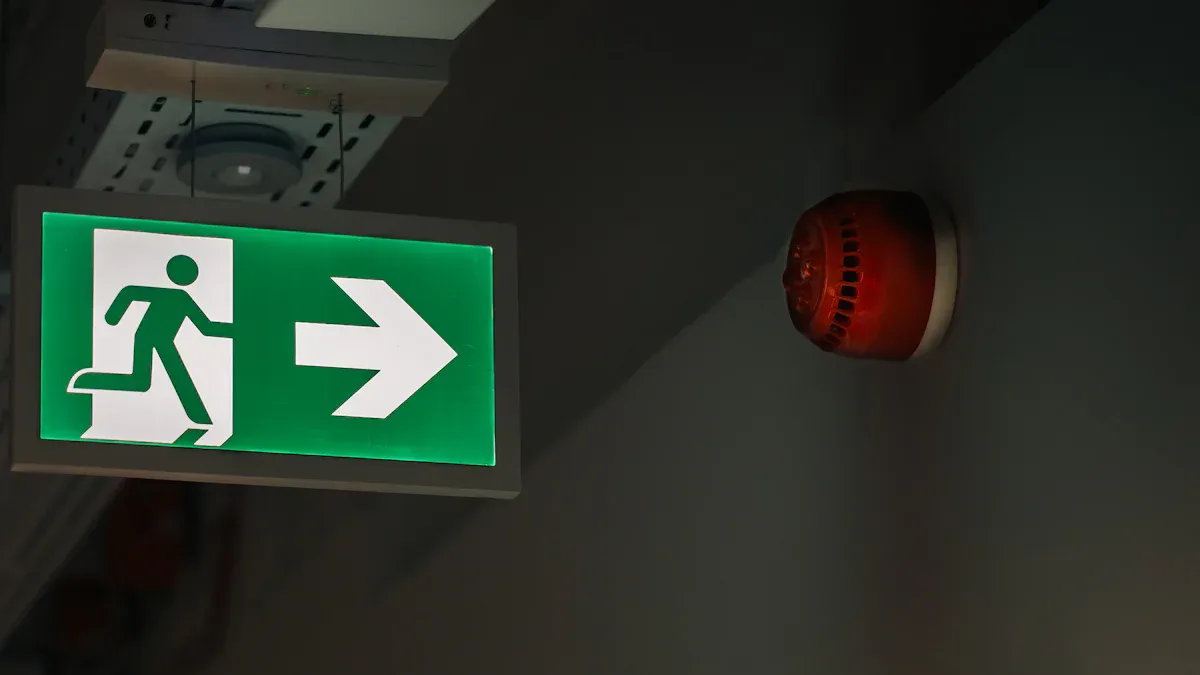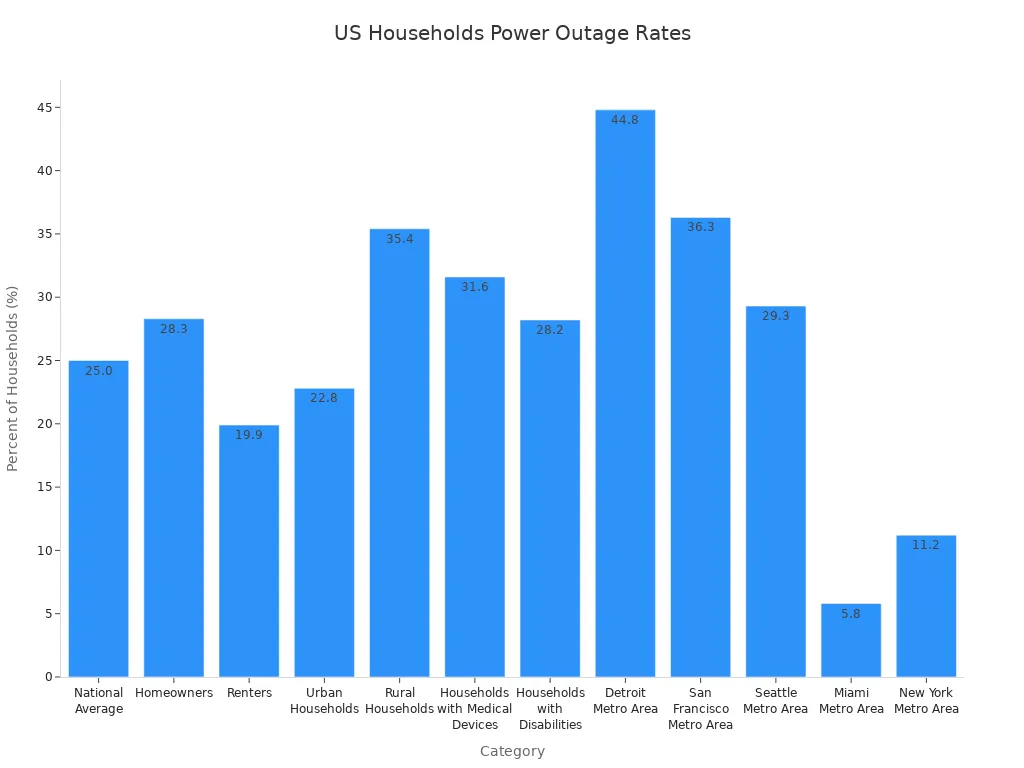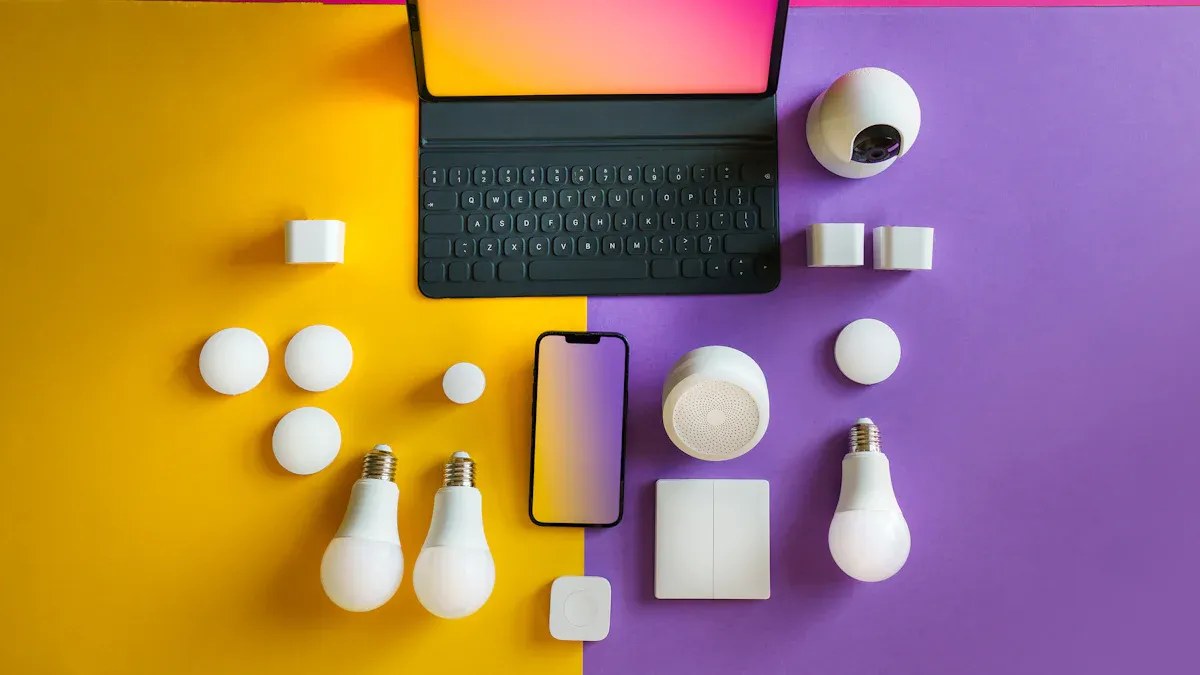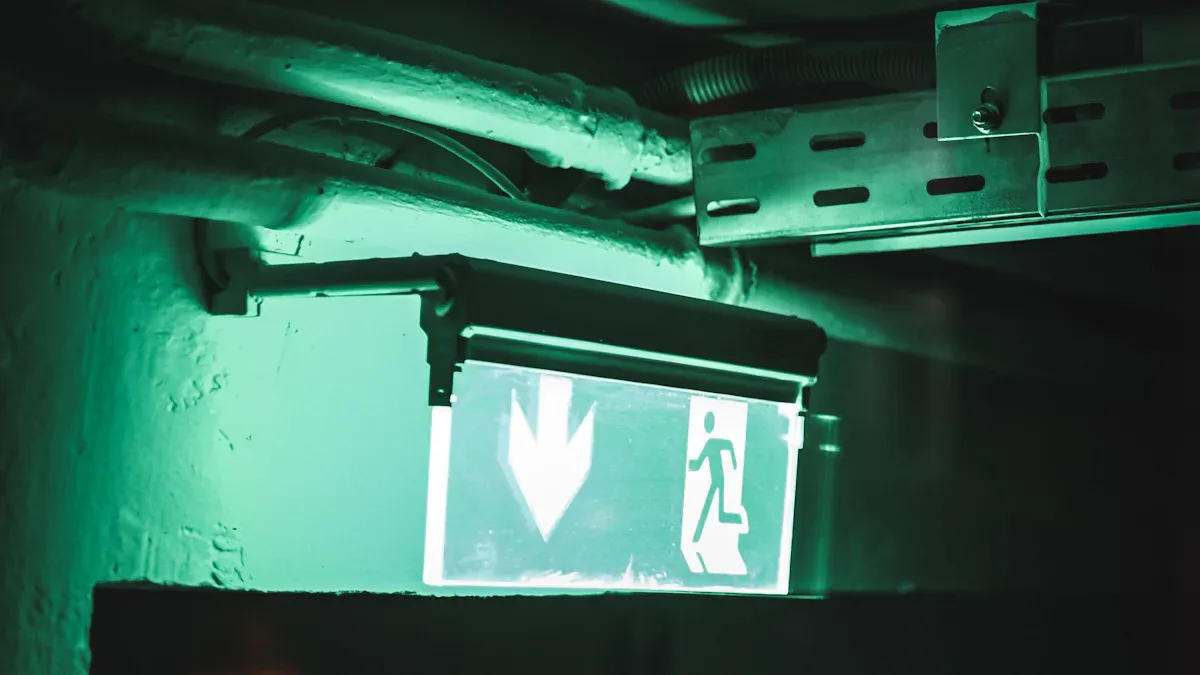Home Emergency Lights: Installation Tips and Product Recommendations for Power Outages

You never know when your home might lose power. In the United States, about 1 in 4 homes lose power each year. Rural homes lose power even more often.
Category | Percentage of Households Experiencing Power Outages Annually |
|---|---|
National Average | Approximately 25% (1 in 4 households) |
Homeowners | 28.3% |
Renters | 19.9% |
Urban Households | 22.8% |
Rural Households | 35.4% |
Households with Medical Devices | 31.6% |
Households with Disabilities | 28.2% |
Detroit Metropolitan Area | 44.8% |
San Francisco Metropolitan Area | 36.3% |
Seattle Metropolitan Area | 29.3% |
Miami Metropolitan Area | 5.8% |
New York Metropolitan Area | 11.2% |

When the power goes out, home emergency lights help a lot. Battery-powered lanterns, solar-powered lamps, and crank-powered flashlights keep your home bright and safe. Emergency lighting helps you walk around and feel less worried. It makes power outages less scary for everyone. You can trust these lights to give comfort and safety. They help you feel calm, whether you live in a city or in the country. Picking the right emergency lighting helps your family stay ready for any outage. If you want to learn more about Led Light, Poduct, or About Us, you are in the right place.
Key Takeaways
Home emergency lights help keep your family safe. They let you move around during power outages. You do not need to use candles, which can be dangerous.
Pick the right emergency light for each room. Use battery-powered lights in bedrooms. Use hardwired LED lights in hallways and stairs.
Test your emergency lights every month. Change batteries or bulbs if needed. This makes sure they work when you need them.
Put emergency lights in important places. Good spots are hallways, stairs, near exits, and kitchens. This gives you better safety and coverage.
Make an emergency kit with flashlights, batteries, lanterns, and chargers. Keep the kit where you can get it fast during outages.
Why Home Emergency Lights Matter
Safety During Outages
When a power outage hits, you want to keep your family safe. Home emergency lights help you see where you are going, even when the rest of the house is dark. You can avoid tripping over furniture or bumping into walls. These lights make it easier to find your way to the bathroom, kitchen, or front door. If you have kids or older adults at home, you know how important safety is during power outages. Emergency lights give you peace of mind because you know everyone can move around safely. You do not have to worry about lighting candles, which can be a fire risk. Instead, you get reliable light that turns on right when you need it. Safety during power outages should always come first, and these lights make it simple.
Tip: Place emergency lights in hallways, staircases, and near exits. This helps everyone find their way fast during an outage.
Comfort and Convenience
Power outages can feel stressful. You might worry about your family or pets. Home emergency lights help you stay calm and comfortable. With these lights, you can check on everyone in the house without stumbling in the dark. You can keep doing important things, like making food, giving first aid, or fixing small problems. Well-lit rooms help lower anxiety and make you feel secure, even when the power goes out.
Emergency lights reduce the risk of trips and falls in dark areas.
You can check on family and pets during a blackout.
You can prepare food, give first aid, and make emergency repairs.
Bright rooms help everyone feel safe and less anxious during a power outage.
When you have the right lights, you turn a scary power outage into a manageable situation. You keep your home safe, comfortable, and ready for anything.
Types of Emergency Lights

When you look for emergency lighting, you will find many choices. Each type of light has its own strengths and weaknesses. Let’s break down the most popular types of led emergency lights so you can pick what works best for your home.
LED Emergency Lights
LED emergency lights are a top pick for many families. These lights use less power and last much longer than old-style bulbs. You get bright, clear lighting right away, even in cold weather. LED emergency lights are tough and do not break easily. They save you money over time because you do not need to replace them often. The main downside is the higher price at first, but you get great value in the long run.
Pros: Energy efficient, long lifespan, instant light, durable, low maintenance.
Cons: Higher upfront cost, possible blue light issues, need proper power supply.
Battery-Powered Options
Battery-powered emergency lights are easy to use. You do not need to worry about wires or outlets. You can move these lights anywhere in your home. They are perfect for renters or anyone who wants simple backup lighting. Just remember to check the batteries often. Some models use rechargeable batteries, which help save money and reduce waste. The American Red Cross and FEMA both say you should use battery-powered lighting instead of candles during emergencies. This keeps your home safe from fire.
Cons: Need regular battery checks, lower brightness, battery disposal can harm the environment.
Solar-Powered Lights
Solar-powered emergency lights work even when the power stays out for days. These lights charge during the day and shine at night. You do not need to buy batteries or worry about running out of power. Solar lights are great for the planet and save you money. They work best where they get lots of sunlight. If you live in a cloudy area, you may need another backup.
Plug-In and Rechargeable
Plug-in and rechargeable emergency lights give you strong, steady lighting. You plug them in, and they charge while the power is on. When the power goes out, they switch on by themselves. These lights are energy efficient and last a long time. You can use them in many places, but you need to check if they fit your fixtures. Over time, the battery backup may wear out, so plan to replace it when needed.
Benefits | Limitations |
|---|---|
Energy efficient, long lifespan | Battery backup degrades over time |
Automatic activation during outages | Higher upfront cost |
Flexible use in many settings | May not fit all fixtures |
LED Emergency Lights with Battery Backup
LED emergency lights with battery backup give you the best of both worlds. You get bright, reliable lighting and a built-in battery backup for emergencies. These lights turn on right away when the power fails. They are perfect for hallways, staircases, and exits. You can trust them to keep your home safe and bright during any emergency.
Tip: Place led emergency lights with battery backup in key spots like hallways and near exits for the best coverage.
Choosing Home Emergency Lights
Key Features
When you pick a led emergency light, look for features that help you. Not all emergency lights are the same. Some have extras that help in hard times. Here’s a table to compare them:
Feature Category | Key Features / Types / Battery Options |
|---|---|
Features | |
Types | Area Light, Cap Light, Flashlight, Headlamp, Lantern, Large Power Banks, Lightweight Power Banks, Pocket Light, Rechargeable, Work Light |
Battery Options | Alkaline, Rechargeable, Rechargeable or Alkaline |
Pick led emergency lights that are bright and strong. Some can charge your phone if you need it. Others have magnets or clips to stick anywhere. Waterproof and tough lights last longer if you drop them. Some lights have strobe or red modes for emergencies. Rechargeable batteries save money and help the earth.
Tip: Get your emergency lights before you lose power. Use different lights for people, rooms, and big spaces for the best light.
Matching Needs to Rooms
Each room needs a different kind of light. Make sure you put led emergency lights in the right places. Here are some ideas:
Put battery lights in bedrooms and living rooms. These are easy to move and do not need wires.
Use hardwired led emergency lights in halls, stairs, and near doors. These turn on by themselves when the power goes out.
Place lanterns or area lights in kitchens or basements. These give lots of light for big rooms.
Add flood lights outside or in garages for more safety.
Always put lights near doors and ways out. This helps everyone find the exit fast.
Test your lights often. Make sure the batteries work and the lights turn on when you need them.
Safety Certifications
Always check for safety certifications when you buy led emergency lights. These marks show your lights follow strict rules and will work when needed. Here’s a table to help you know what to look for:
Certification | Region/Scope | Key Focus Areas | Importance for Residential Emergency Lighting |
|---|---|---|---|
United States & Canada | Safety, reliability, electrical safety codes | Meets North American safety standards | |
ETL | United States & Canada | Safety standards, quick certification | Trusted for home safety |
United States | Emergency lighting and power equipment standard | Meets life safety and fire codes | |
CE | Europe | Health, safety, environmental protection | Required for European homes |
RoHS | Europe | Restriction of hazardous substances | Safer for the environment |
CB | International | IEC standards, low voltage directive | Global safety compliance |
SAA | Australia/New Zealand | Electromagnetic compatibility, safety standards | Regional safety requirements |
UL 924 is very important in the United States. It means your led emergency lights will work in a real emergency and follow safety codes. Always look for these marks when you pick led emergency lights for your home.
Installation Tips

Placement for Best Coverage
You want your emergency lights to shine where you need them most during a power outage. Place them along hallways, stairwells, and near exits so everyone can find their way out safely. Make sure you cover corners, landings, and any spots where people might trip. Mount emergency lights about six feet above the floor for the best coverage. Don’t forget to light up ramps, aisles, and exit discharge areas. If you have a generator or backup power source, check that these lights will work even if the main electricity fails. Test your setup often to make sure every path stays bright when the power goes out.
Tip: Use LED emergency lights for instant illumination and long life. They help you save on backup power and reduce the need for frequent replacements.
Electrical Connections
Before you start installation, always turn off the power at the breaker. Use the right wire size and color codes—live, neutral, and ground. Route the wires through the knockout holes in the backplate, then secure the light to the electrical box. Connect the wires tightly and use connectors or blocks to keep things safe. Attach the battery leads, making sure you match the polarity. After you finish, turn the power back on and check that the charge light comes on. If you use a generator, make sure it can handle the load for all your emergency lights and backup power needs.
Wall Mounting
Pick mounting hardware that matches your wall type. Use masonry anchors for brick or concrete, and toggle bolts or wall anchors for drywall. Mark your mounting points, drill holes, and insert the anchors. Secure the emergency light so it doesn’t wobble or shift. For thermoplastic lights, you can often mount them on drywall, but anchoring into studs gives extra stability. Always follow the manufacturer’s instructions for a safe installation.
Compliance and Codes
You want your emergency lights to meet safety codes. UL924 and NFPA 101 set the rules for how long lights must stay on—at least 90 minutes after a power outage. The lights should turn on within 10 seconds of losing power. Test your system every month with the push-to-test button, and do a full 90-minute test each year. Keep records of your tests to stay compliant. If you use a generator or backup power, make sure your emergency lights work with these systems and meet all code requirements.
Using Emergency Lights
Regular Testing
You want your emergency lights to work every time the power goes out. Regular testing helps you catch problems before they become real emergencies. Each month, walk around your home and check every emergency light. Press the test button to make sure the lights turn on. Look for any damage or signs that the battery backup might not work. Check that the charging light is on when the power is back. Once a year, schedule a full test. During this annual check, let your emergency lights run for at least 90 minutes. This shows if the emergency backup batteries can last through a real outage. If you notice any lights flickering or not staying on, replace them right away. Keeping a simple log of your tests helps you remember when you last checked each light.
Tip: Monthly checks help you spot battery failures, burnt-out bulbs, or wiring issues before an emergency happens.
Maintenance
Taking care of your emergency lights keeps them ready for action. Wipe down the lenses and housings to keep them bright. Dust and dirt can block the light and make it dim. Inspect the cables and connections for any signs of wear or loose wires. Replace burnt-out bulbs as soon as you notice them. Make sure the battery backup system is charging and not overheating. If your lights have fans or vents, keep them clear so heat can escape. Use lower brightness settings when possible to save energy and extend the life of your emergency lights. Turn off any lights you do not need to avoid draining the battery backup.
Clean fixtures and lenses regularly.
Check for loose wires or damaged cables.
Replace bulbs and test switches often.
Keep vents and heat sinks clear.
Battery Care
Your emergency lights depend on strong batteries. Good battery care means your lights will shine when you need them most. Inspect batteries for leaks, swelling, or corrosion. Never overcharge your batteries, as this can cause heat damage. Use only the charger that matches your battery type. When you need to replace a battery, always match the voltage and type. Wear gloves and safety glasses when handling batteries. Work in a clean, well-ventilated space. Disconnect the battery from power before you start any work. If you see signs like swelling, leaks, or if your lights do not last 90 minutes, it is time to replace the battery. Dispose of old batteries at a recycling center to protect the environment. Emergency backup batteries should always be ready for the next outage.
Note: Regular cleaning and inspection help your emergency lights last longer and keep your home safe during any emergency.
Product Recommendations
Choosing the right emergency lights for your home can feel overwhelming. You want lights that are bright, reliable, and easy to use when the power goes out. Let’s look at some of the best options for different needs. I’ll break down the top picks for led emergency lights, battery-powered models, large spaces, and budget-friendly choices. You’ll see what makes each one special and how they can help you stay safe during an emergency.
Best LED Emergency Lights
You want led emergency lights that turn on fast and last a long time. These lights use less energy, stay cool, and give you bright light when you need it most. Many experts and homeowners trust these models for their homes. Here’s a quick look at some of the top-rated led emergency lights:
Product Name | Key Features | Pros | Cons | Best Use |
|---|---|---|---|---|
Rechargeable, 120V, 40W, 3 hours emergency light | Auto recharge, blinking indicator, easy to install | Not for dimmer switches | Bedrooms, living rooms, hallways | |
Flyhoom | Rechargeable, remote control, 4 modes, USB charging | Portable, up to 15 hours, timer control | Not waterproof | Indoor, quick setup |
GE Lighting | Backup battery, 8W LED, soft white, self-charging | Trusted brand, works as bulb and flashlight | Needs careful reading of instructions | General home use |
JackonLux | Rechargeable, impact-resistant, 2-pack, 4 hours light | Durable, good for indoor and camping | None | Home, camping |
Neporal | Emergency LED bulb, 15W, hook, 4-5 hours light | Versatile, easy to use, sold in packs | Not for multi-bulb fixtures | Emergency, outdoor activities |
These led emergency lights give you strong, steady light. They use less power than old bulbs and last up to 10 years. You save money and help the planet at the same time. Most of these lights work right out of the box. You just screw them in or hang them up. Some even double as flashlights or lanterns. You can trust them to light up your home during any emergency.
Note: LED emergency lights do not get hot and do not have mercury. They are safer for your family and better for the environment.
Top Battery-Powered Picks
Battery-powered emergency lights are a must for every home. You can move them anywhere, and they work even if the power stays out for a long time. When you pick a battery-powered light, look for long battery life, strong brightness, and easy charging. Here are some top choices:
Eveready HL52
This led emergency light shines bright with 39 LEDs and lasts up to 15 hours. It turns on by itself when the power goes out. You do not need to worry about changing batteries often.Pros: Long battery life, auto-on feature, bright light
Cons: Takes longer to charge, no brightness adjustment
Philips Emergency LED
This light is lightweight and strong. It gives you up to 4 hours of bright light and has a rechargeable battery.Pros: Bright, easy to carry, strong build
Cons: Longer charging time, no dimming
Flyhoom Rechargeable Bulb
You get four lighting modes and a remote control. It is easy to hang or carry.Pros: Portable, timer control, up to 15 hours of light
Cons: Not waterproof, indoor use only
When you choose battery-powered led emergency lights, check for UL 924 certification. This means the lights will last at least 90 minutes during an emergency. Look for models with LiFePO4 batteries. These batteries last longer, charge faster, and work well in hot or cold weather. You want lights that are easy to test and do not need much care. Regular testing keeps your emergency lights ready for any power outage.
Tip: Keep extra batteries or a backup power bank handy. This helps your lights stay on even during long emergencies.
Best for Large Spaces
If you have a big room, basement, or open area, you need led emergency lights that cover more space. Regular bulbs may not be enough. You want lights that shine in all directions and last for hours. Here are some great options for large spaces:
MORF® 380 Lumen 2-in-1 Lantern
This rechargeable led lantern gives you 360-degree light. You can use it as a lantern or take off the handheld light for smaller tasks. It has high, low, night light, and red flash modes. It runs on 4 AA batteries and is splash-resistant.Pros: Wide area lighting, multiple modes, hands-free use, indoor/outdoor
Cons: Needs batteries, not fully waterproof
Wipro Coral LED Lantern
This led emergency light has 84 LEDs and a long battery life. It is portable and bright, perfect for lighting up big rooms or outdoor spaces.Pros: Very bright, long battery life, easy to move
Cons: No advanced features, longer charging time
LED Emergency Lights with Battery Backup
These lights mount on walls or ceilings and turn on automatically during a power outage. They use strong led bulbs and have a built-in battery backup. You can use them in hallways, stairwells, and large rooms.Pros: Reliable, code-compliant, covers large areas
Cons: Needs installation, not portable
You want led emergency lights that give you broad, even light. Look for models with adjustable heads or lanterns that shine in every direction. Make sure the battery backup lasts at least 90 minutes. This keeps your home safe and bright until the power comes back.
Budget-Friendly Options
You do not have to spend a lot to get safe, reliable emergency lights. Many led emergency lights cost less but still meet safety codes and work well during a power outage. Thermoplastic emergency lights are a smart choice if you want to save money. They are light, easy to install, and give you at least 90 minutes of backup light.
Thermoplastic LED Emergency Lights
These lights cost between $20 and $50. They have flame-retardant plastic cases and strong led lamp heads. You can use them in bedrooms, hallways, or offices.Pros: Low price, easy to mount, safe, code-compliant
Cons: Not as tough as metal units, best for indoor use
JackonLux Rechargeable LED Bulb
This two-pack gives you up to 4 hours of emergency light. The bulbs are impact-resistant and easy to use.Pros: Affordable, durable, good for home and camping
Cons: Not for multi-bulb fixtures
Neporal Emergency LED Bulb
Sold in packs of four, these bulbs are easy to use and last 4-5 hours. They come with hooks for hanging.Pros: Budget-friendly, versatile, easy to hang
Cons: Not for use in fixtures with more than one bulb
You can use these led emergency lights in most rooms. Just remember to test them every month and keep spare batteries or bulbs ready. Even budget models can keep your home safe and bright during an emergency if you take care of them.
Note: Place your budget-friendly led emergency lights in safe spots where they will not get bumped or damaged. Keep a log of your tests to make sure your lights are always ready.
Preparation Checklist
Inventory Supplies
You need a power outage emergency kit with all the basics. Gather things that help you stay safe and comfortable if the power goes out. Your kit should have:
Flashlights: Choose strong ones for each room.
Headlamps: These let you use both hands while you move or fix things.
Chem lights: These glow sticks last up to 12 hours and help light dark places or signal for help.
Batteries: Always keep extra batteries, especially rechargeable ones, in your kit. Store them apart so they do not leak.
Lanterns: These help light up big rooms so you can see everyone.
Spare cell phone charger: You need your phone to call for help or get news.
Tea candles: Only use these if you have no other choice, because they can be dangerous.
Backup lighting: Have a mix of flashlights, lanterns, and headlamps in your kit.
A good emergency kit can also have a small generator. This helps if you need to run medical devices or keep food cold. Make sure your generator works and has enough fuel. Your kit should help you for at least 24 hours.
Tip: Check your kit every few months. Change old batteries and test your lights to make sure they work.
Placement Plan
Put your emergency kit and lights where you can reach them fast. Place emergency lights in hallways, stairs, bedrooms, kitchens, and near doors. This helps everyone find their way when the power is out. Use LED lights because they last long and save energy. Mount lights about six feet high for the best light. Keep your kit easy to grab, not hidden away.
Here’s a table to help you plan:
Area | What to Place There | Why It Matters |
|---|---|---|
Hallways | LED lights, flashlight | Safe path to exits |
Staircases | Headlamp, lantern | Prevent trips and falls |
Bedrooms | Flashlight, chem light | Easy access at night |
Kitchen | Lantern, spare charger | Food prep and phone charging |
Near exits | Emergency kit, backup lighting | Fast evacuation during emergencies |
If you use a generator, keep it outside and away from windows. Never use a generator inside. Test your generator as part of your kit routine.
Common Mistakes
People sometimes make easy mistakes with their emergency kits. Do not put flashlights or batteries where you cannot reach them. Keep them close, not buried in a drawer. Do not use candles as your main light. Candles can start fires, especially with kids or pets. Chem lights are safer for everyone.
Some people forget to unplug big appliances during a power outage. This can break them when the power comes back. Always unplug big things and turn off your generator before the power returns. Do not ignore water leaks near anything electric. Water and electricity are dangerous together.
Other mistakes are:
Not checking if the outage is only in your home. Always check your breakers and ask your neighbors.
Leaving the fridge door open. Keep it closed to protect your food.
Forgetting how to open electric gates by hand. Practice this before you need it.
Turning off all switches, which makes it hard to know when the power is back.
Remember: A good emergency kit and a working generator help keep your home safe and comfortable during any power outage.
You never know when a power outage will hit your home. When outages happen, you want to feel ready and safe. Using home emergency lights and a solid emergency kit helps you handle any emergency. A checklist keeps you organized and calm during a power outage. Experts say that planning for outages with the right emergency kit, lighting, and tools saves time and stress. Share this guide with friends or print the checklist for your family. You can face any outage with confidence and keep your home safe.
FAQ
How often should I test my emergency lights?
You should test your emergency lights once a month. Press the test button to make sure they turn on. Once a year, let them run for 90 minutes to check the battery backup.
Can I use regular LED bulbs as emergency lights?
Regular LED bulbs do not work during power outages unless they have a built-in battery. Look for bulbs labeled as “emergency” or “battery backup” to stay safe when the power goes out.
Where is the best place to install emergency lights?
Place emergency lights in hallways, staircases, and near exits. You want to light up paths you use most. Bedrooms and kitchens are also smart spots.
What should I do if my emergency light battery leaks?
If you see a leaking battery, wear gloves and clean up the area. Replace the battery right away. Recycle old batteries at a local center. Never touch battery leaks with bare hands.
See Also
A Guide To Outdoor Lamp Models, Features, And Setup
Design And Installation Tips For Flood Lighting Systems
Exploring Outdoor LED Light Types, Benefits, And Installation

